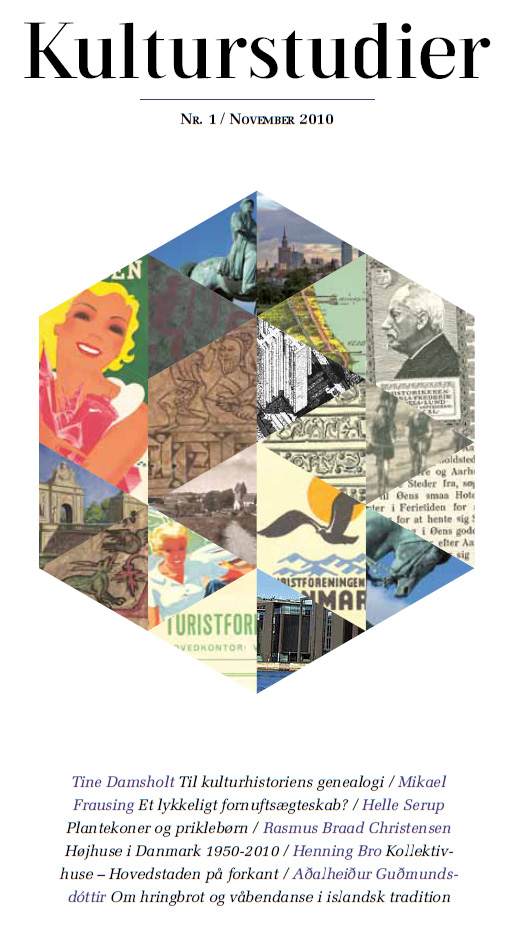Højhuse i Danmark 1950-2010
DOI:
https://doi.org/10.7146/ks.v1i1.3884Nøgleord:
højhuseResumé
Med udgangspunkt i det moderne højhus' fødsel i det 19. århundredes USA samt fænomenets internationale historie, belyser artiklen højhusets historie og udbredelse i Danmark. Fra velfærdsstatens funktionalistiske boligkolosser i midten af det tyvende århundrede, over 1970'erne og 80'ernes modreaktion og 'småt er godt'-mentalitet til de seneste årtiers individuelle og amerikansk inspireredeprestige-projekter med vartegnsambitioner, sættes den danske udvikling ind i en europæisk kontekst og prioriteret bevidsthedshistorisk forklaringsramme. Siden midten af det tyvende århundrede har erhvervshøjhuse i bycenteret hørt til de mest karakteristiske træk ved storbyers udvikling verden over, men i Danmark er den slags højhuse endnu relativt sjældne. Også i danske byer peger udviklingen i de seneste år dog i retning af flere høje, markante byggerier i eller nær bymidten.
Abstract:
In recent decades, the distinctive urban setup, with a nucleus dominated by clusters of office towers, has spread to most parts of the world. Economic growth and structural conditions are obviously of fundamental importance for this development, but as the present article shows, the limited construction of such centrally located high-rise buildings in Danish (and European) cities may also be put into a framework of history of consciousness. The first modern skyscrapers were erected in American cities in the late 19th Century, but it was not until the middle of the 20th Century that a related, but dissimilar development gained momentum in Europe and Denmark. In Copenhagen, as well as in other European cities, office towers fitted badly into the the maze of streets in the city centres, and they also conflicted with the laws that restricted building heights. Because of the post-war shortage of housing and the rapid economic growth of the 1950s and -60s, the first high-rise buildings in Denmark were built in the mid-1950s in the form of suburban residential towers. Since then, these pre-fabricated concrete towers have affected the Danish townscape for better and perhaps especially for worse; and this may be one of the reasons why high-rise buildings fell into disrepute in Denmark. At any rate, the first generation of high-rise buildings in this country was mostly suburban, and a child of European modernism and functionalism. Due to a fear of Americanization and the ruining of Copenhagen"s "unique" low skyline, only a few "American" highrise buildings were allowed to be built in Copenhagen"s inner city in this period. From the early 1970s until 1990, practically no high-rise buildings were constructed in Denmark. The building activity was affected by low economic growth; and in addition, the bad experience from the 1950s and -60s influenced the new catchword of the building industry: dense, low. Since the last decade of the 20th Century, however, high-rise buildings have once again become fashionable in Denmark. Not all types of high-rise buildings, though, but characteristic and unique "American" commercial high-rise buildings in or near city centres. This development may be seen not only in Copenhagen, but also in several of the larger provincial towns. Public opposition to these towers is still significant, but as a consequence of increased globalization and the race for attracting multinational companies and the favour of the professions, municipal councils in Denmark are bending over backwards to signal progressiveness and an attractive business environment - for instance by stimulating the
construction of office towers.
Downloads
Publiceret
2010-11-30
Citation/Eksport
Christensen, R. B. (2010). Højhuse i Danmark 1950-2010. Kulturstudier, 1(1), 76–99. https://doi.org/10.7146/ks.v1i1.3884
Nummer
Sektion
Artikler
Licens
Tidsskriftet forbeholder sig ret til førsteudgivelsen, mens ophavsretten til artiklen tilfalder forfatteren.
Artikler udgivet af Kulturstudier licenseret under en Creative Commons Navngivelse-IkkeKommerciel-IngenBearbejdelse 4.0 International Licens





